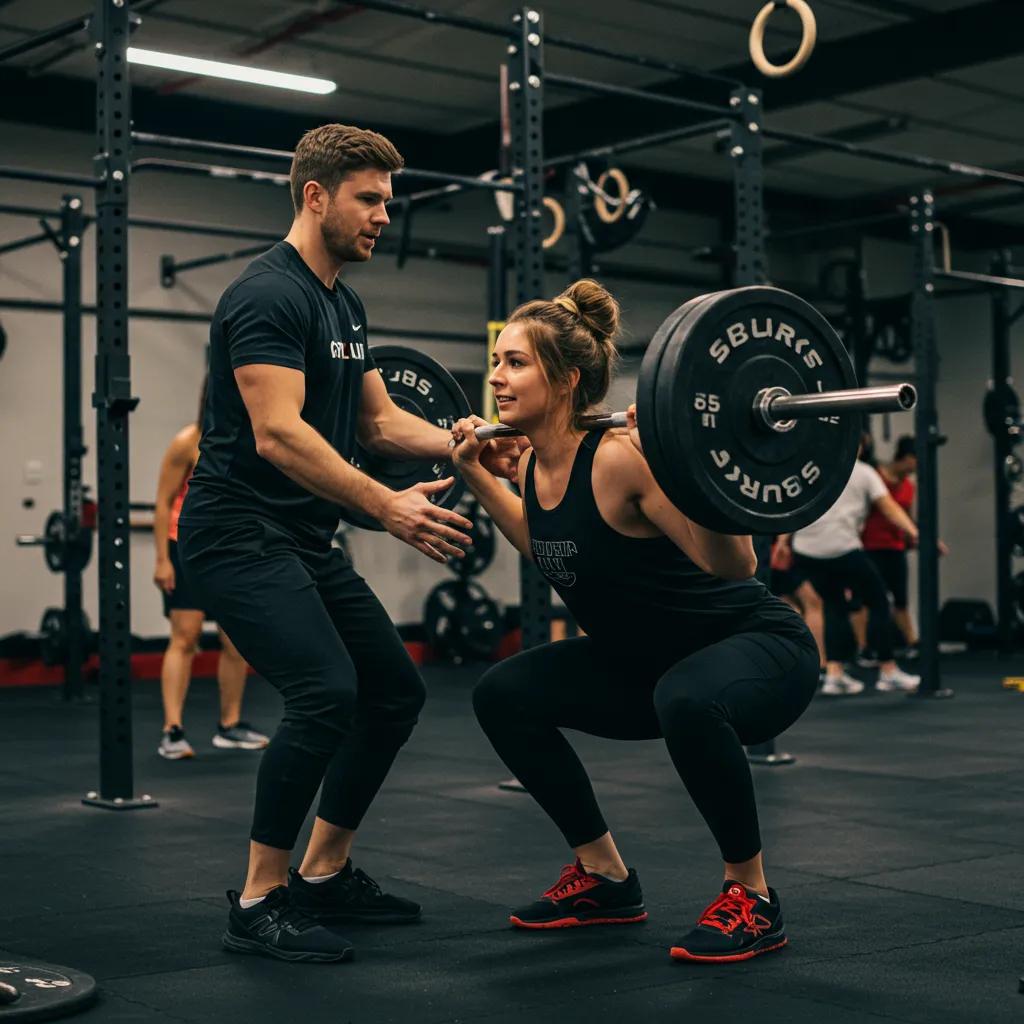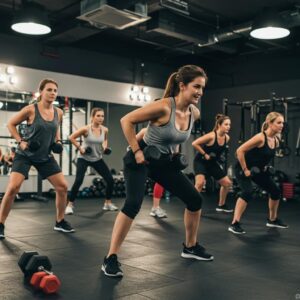The Benefits of Strength-Focused Workout Classes on the Upper East Side

Strength-focused workout classes concentrate on progressive resistance, compound movements, and coached technique to build muscle, boost bone health, and improve day-to-day function for Upper East Side residents. This article explains what strength-focused classes are, why they work physiologically, and how local programming can fit different goals from weight loss to joint health. Many busy New Yorkers seek efficient, evidence-based training that produces measurable changes; strength classes deliver that through hypertrophy, mechanical bone loading, and metabolic adaptations.
Below we map the core benefits, the class modalities you’ll find on the Upper East Side, practical programming for metabolism and body composition, and the psychological and community advantages that support consistency. Readers will learn how to choose between group sessions, small-group or personal training, how HIIT-strength hybrids fit into a plan, and simple metrics to track progress. Expect research-backed mechanisms, actionable tips, and local-first guidance to help you pick the right strength training option in the UES.
What Are the Key Benefits of Strength-Focused Workout Classes on the Upper East Side?
Strength-focused classes improve muscle mass, functional strength, bone density, metabolic rate, and mental resilience by using progressive overload, multi-joint lifts, and coached progressions. The primary mechanisms include hypertrophy (muscle fiber growth), Wolff’s law for bone adaptation through mechanical loading, and elevated post-exercise oxygen consumption (EPOC) that modestly increases daily calorie expenditure. Below is a quick list of the top benefits and one-sentence mechanisms to capture the essentials for quick reference and featured-snippet opportunities.
- Increased muscle mass: Structured progressive overload stimulates hypertrophy and strength gains.
- Improved bone health: Mechanical loading from weighted exercises promotes bone formation and density.
- Metabolic boost: Higher lean mass and acute afterburn support better body composition.
- Mental and social gains: Regular training reduces stress and builds confidence through community support.
The table below summarizes these benefits with mechanisms and expected outcomes to help readers quickly scan what each benefit yields and why. Understanding these mechanisms sets up the next discussion on how classes target functional strength and specific bone-loading strategies.
| Benefit | Mechanism | Expected Outcome |
|---|---|---|
| Muscle mass | Progressive overload/hypertrophy | Noticeable strength and size gains in 8–12 weeks |
| Bone density | Mechanical loading (Wolff’s law) | Reduced osteoporosis risk; stronger bones over months |
| Metabolic rate | Increased lean mass + EPOC | Improved resting metabolism and body composition |
| Mental health | Neurochemical changes, social support | Reduced stress and improved adherence |
This EAV table clarifies the link between physiological mechanisms and realistic outcomes, and it naturally leads into how classes specifically build muscle and functional capacity.
How Do Strength Classes Improve Muscle Mass and Functional Strength?

Strength classes drive hypertrophy by programming progressive overload and prioritizing compound movements such as squats, deadlifts, presses, and loaded carries that recruit multiple muscle groups. Coaches use incremental load increases, volume regulation, and periodized cycles to stimulate muscle fiber adaptation while minimizing injury risk. Functional strength emerges when programming emphasizes movement patterns that replicate daily tasks—lifting, carrying, pushing—and integrates accessory work to balance stability and mobility. Expect measurable improvements in strength metrics (e.g., increased barbell or dumbbell loads) within 6–12 weeks, with consistent sessions and adequate recovery producing durable gains. These training principles also prepare participants to transition into more individualized personal training if specific goals require deeper customization.
Progressive Overload in Strength Training: Load vs. Repetition Progression
Progressive overload is a principle of resistance training exercise program design that typically relies on increasing load to increase neuromuscular demand to facilitate further adaptations. However, little attention has been given to another way of increasing demand—increasing the number of repetitions. This study aimed to compare the effects of two resistance training programs: (1) increasing load while keeping repetition range constantvs(2) increasing repetitions while keeping load constant. We aimed to compare the effects of these programs on lower body muscle hypertrophy, muscle strength, and muscle endurance in resistance-trained individuals over an 8-week study period.
Progressive overload without progressing load? The effects of load or repetition progression on muscular adaptations, D Plotkin, 2022
In What Ways Do Strength Workouts Enhance Bone Density and Joint Health?
Bone adapts to loads placed upon it; targeted resistance training places safe, progressive stress on the skeleton, signaling osteogenesis and improved bone mineral density over time. Exercises that compress the skeleton—such as loaded squats, deadlifts, and weighted step-ups—stimulate bone formation via mechanotransduction consistent with Wolff’s law. Classes on the Upper East Side that include graduated loading and technique coaching reduce joint stress while strengthening surrounding musculature, which protects joints and decreases injury risk. Modifications—lower impact progressions, bands, and tempo adjustments—make bone-loading accessible for older adults and those with joint considerations, enabling a safe path to stronger bones and more resilient joints.
Which Types of Strength Training Classes Are Available on the Upper East Side?
Upper East Side options usually include group strength classes, small-group or boutique strength training, HIIT-strength hybrids, and one-to-one personal training; each modality suits different goals, budgets, and experience levels. Group classes provide structured programming, community motivation, and efficiency for general strength and conditioning. Personal training offers tailored progressions and corrective coaching for specific rehab or performance goals, while HIIT-strength hybrids blend intervals with resistance work for time-efficient conditioning. Below is a comparison table to help you decide which format matches your priority—community, personalization, or metabolic conditioning.
- Group strength classes: Best for consistency, community, and structured progression.
- Personal training sessions: Best for individualized programs and faster progress toward specific goals.
- HIIT-strength classes: Best for cardiovascular conditioning combined with strength maintenance.
This comparison helps define next steps for choosing between communal schedules and personalized coaching, which we explore in the following subsections.
What Are the Differences Between Group Strength Classes and Personal Training?
Group strength classes deliver standardized sessions where coaches cue large groups through progressive programming, making them cost-effective and socially motivating. The coach-to-client ratio is higher, so individual technique correction is less frequent, but classes use scalable loading and clear progress markers to guide improvement. Personal training provides bespoke programming, close technical feedback, and targeted progressions for rehabilitation, sport performance, or accelerated results. Choosing between them depends on how quickly you want outcomes, how much personalized attention you need, and whether community accountability is an important driver for adherence.
How Does HIIT Strength Training Complement Traditional Strength Workouts?
HIIT-strength hybrids interleave brief, intense intervals with resistance exercises to raise cardiovascular fitness while maintaining or modestly building strength. This format increases caloric expenditure during and after sessions (EPOC) and improves conditioning without sacrificing functional strength when programmed with compound lifts and appropriate load. For optimal results, alternate dedicated heavy strength days with HIIT-strength sessions to prioritize neural recovery and maximal strength gains while still benefitting from metabolic conditioning. Thoughtful periodization ensures you gain both strength and endurance without overtraining.
Resistance Training Overload: Load vs. Repetitions for Strength and Muscle Mass
The aim of this study was to compare the effects of progressive overload in resistance training on muscle strength and cross-sectional area (CSA) by specifically comparing the impact of increasing load (LOADprog) versus an increase in repetitions (REPSprog). We used a within-subject experimental design in which 39 previously untrained young persons (20 men and 19 women) had their legs randomized to LOADprog and REPSprog. Outcomes were assessed before and after 10 weeks of training. Muscle strength was assessed using the one repetition maximum (1RM) test on the leg extension exercise, and the CSA of the vastus lateralis was assessed by ultrasonography. Both protocols increased in CSA values from pre (LOADprog: 21.34±4.71 cm²; REPSprog: 21.08±4.62 cm²) to post (LOADprog: 23.53±5.41 cm², REPSprog: 23.39±5.19 cm²), with no difference between them (P+>+0.05). In conclusion, our findings indicate that the progression of overload through load or repetitions can be used to promote gains in strength and muscle hypertrophy in young men and women in the early stages of training.
Effects of resistance training overload progression protocols on strength and muscle mass, 2024
How Can Strength Training Classes on the Upper East Side Boost Metabolism and Support Weight Loss?
Strength training elevates resting metabolic rate by increasing lean muscle mass and produces acute increases in post-exercise oxygen consumption that contribute to incremental calorie burn after workouts. While EPOC is real, recent studies indicate its magnitude is moderate—strength sessions can add a modest additional caloric expenditure over 24 hours rather than large one-time burns—so combining resistance training with nutrition and periodic higher-intensity work yields the best fat-loss outcomes.
Below is a set of practical programming tips and a concise EAV table linking mechanisms to actionable advice for leveraging metabolic benefits in class settings.
- Prioritize compound lifts with progressive overload to increase lean mass.
- Include occasional higher-intensity intervals after strength blocks for metabolic spikes.
- Track strength benchmarks rather than scale weight alone to measure body-composition progress.
| Mechanism | How It Works | Practical Tip |
|---|---|---|
| Lean mass increase | Boosts resting metabolic rate | Focus on compound lifts and progressive overload |
| EPOC (afterburn) | Elevated post-exercise oxygen consumption | Add short high-intensity intervals post-strength sets |
| Body composition change | Muscle-to-fat ratio improves energy use | Use strength benchmarks and progress photos to track change |
This table ties mechanisms to real programming decisions and transitions into a closer look at EPOC and realistic expectations in the next subsection.
What Is the Afterburn Effect and How Does It Impact Fat Loss?
EPOC represents the extra oxygen your body consumes post-exercise to restore metabolic homeostasis, which burns additional calories after a workout and supports fat-loss efforts when combined with overall energy balance. Strength sessions that use heavier loads and short rest intervals, or HIIT-strength hybrids, tend to generate larger EPOC than low-intensity steady-state workouts, though the absolute calorie amount is modest. Expect EPOC to be a supportive factor rather than the main driver of fat loss; consistent resistance training that builds lean mass will have a more sustained impact on resting energy expenditure. Programming strategies that alternate heavy strength with metabolic conditioning maximize both muscle retention and caloric burn safely.
How Do Strength Workouts Improve Body Composition and Energy Levels?
Strength training increases lean muscle, which improves basal metabolic rate and daily functional capacity; participants often report better energy, stamina, and ease performing activities of daily living. Practical measurement approaches include tracking lifts, body composition scans when available, and progress photos—strength benchmarks like increased squat or deadlift loads are reliable proxies for improved body composition. Regular resistance work also enhances insulin sensitivity and mitochondrial function, contributing to improved metabolic health and sustained energy levels. These physiological gains support both aesthetic and performance goals and naturally introduce the importance of mental health and community consistency discussed next. our method building strength and community at ts fitness.
How Do Strength-Focused Classes on the Upper East Side Support Mental Health and Community Engagement?

Strength training produces neurochemical benefits—endorphin release, reduced cortisol, and improved neurotransmitter balance—that help lower anxiety and enhance mood, while structured classes create social bonds that increase accountability and adherence. Beyond biochemistry, mastering progressively heavier loads builds self-efficacy and confidence that transfers to non-fitness areas of life. The Upper East Side’s studio environment often provides scheduled classes, peer support, and habitual cues that help busy residents maintain consistency amid demanding routines. The next section explains the specific mental-health outcomes and offers practical ways to tap the local fitness community for sustained motivation.
Strength-focused classes promote mental health and social engagement in several ways:
- Mood improvement: Regular resistance training triggers endorphins and reduces stress hormones.
- Confidence and self-efficacy: Visible strength gains translate to higher daily self-confidence.
- Community accountability: Scheduled classes and peer relationships increase long-term adherence.
This list highlights how psychological and social mechanisms complement physiological benefits, encouraging readers to evaluate class culture and coaching fit when selecting a program on the Upper East Side.
What Mental Health Benefits Are Linked to Regular Strength Training?
Regular resistance training reduces symptoms of anxiety and depression through exercise-induced neurochemical changes and improved sleep quality, while structured progress builds a sense of mastery and control that supports long-term mental wellbeing. Research in recent years continues to show exercise as an effective adjunct for mood regulation, and strength training specifically offers measurable improvements in self-esteem as performance improves. Frequency recommendations for mood benefits typically align with 2–4 sessions per week, which balances stimulus with recovery. As mental health improves, adherence and community engagement often strengthen, creating a positive feedback loop that supports continued physical progress.
How Does the UES Fitness Community Enhance Motivation and Consistency?
Local fitness communities on the Upper East Side create accountability through regular schedules, peer check-ins, and shared progress tracking, making it easier to sustain a training habit despite a busy city lifestyle. To leverage community benefits, choose classes with consistent scheduling, approachable coaching, and clear progress markers, and integrate workouts into weekly routines the same way you schedule work meetings. Engaging with fellow members for mutually agreed check-ins or informal training partners boosts attendance and enjoyment. Evaluating studio atmosphere, coach style, and class structure will help you find the community that best supports your long-term strength and wellness goals.
Frequently Asked Questions
What should I expect during my first strength training class?
During your first strength training class, you can expect a welcoming environment where instructors will guide you through the basics of resistance training. Classes typically start with a warm-up, followed by a series of exercises focusing on major muscle groups. Instructors will demonstrate proper techniques and provide modifications to accommodate different fitness levels. It’s important to communicate any concerns or limitations you may have, as coaches are there to help you feel comfortable and safe while building strength.
How often should I attend strength training classes for optimal results?
For optimal results, attending strength training classes 2 to 4 times per week is recommended. This frequency allows your muscles to adapt and grow stronger while providing adequate recovery time. Consistency is key, so finding a schedule that fits your lifestyle is essential. Additionally, incorporating rest days and varying your workouts can help prevent overtraining and keep your routine engaging. Listening to your body and adjusting your attendance based on how you feel will also contribute to long-term success.
Can strength training help with weight management?
Yes, strength training can significantly aid in weight management. By increasing lean muscle mass, your resting metabolic rate improves, allowing you to burn more calories even at rest. Additionally, strength workouts create an afterburn effect, where your body continues to burn calories post-exercise. When combined with a balanced diet, regular strength training can help you achieve and maintain a healthy weight while improving body composition by reducing fat and increasing muscle mass.
Are there specific strength training classes for beginners?
Many gyms and fitness studios offer beginner-friendly strength training classes designed to introduce newcomers to resistance training. These classes typically focus on fundamental movements, proper form, and building a solid foundation. Instructors will provide modifications and progressions to ensure that everyone can participate safely. Look for classes labeled as “beginner,” “foundational,” or introductory to find the right fit for your experience level and comfort.
How can I track my progress in strength training?
Tracking your progress in strength training can be done through various methods. One effective way is to keep a workout journal where you log the weights lifted, repetitions, and sets completed for each exercise. Additionally, you can take regular body composition measurements, such as body fat percentage or muscle circumference, to assess changes over time. Progress photos can also provide visual evidence of your improvements. Setting specific, measurable goals will help you stay motivated and focused on your journey.
What should I wear to a strength training class?
When attending a strength training class, it’s important to wear comfortable, breathable clothing that allows for a full range of motion. Opt for moisture-wicking fabrics to keep you dry during workouts. Supportive athletic shoes are essential for stability and safety, especially during weightlifting exercises. Avoid overly loose clothing that may get caught in equipment. Additionally, consider bringing a water bottle to stay hydrated throughout the class.
Can strength training classes accommodate individuals with injuries?
Many strength training classes can accommodate individuals with injuries, but it’s crucial to communicate your specific needs to the instructor before the class begins. Experienced coaches can provide modifications and alternative exercises to ensure you can participate safely while avoiding aggravation of your injury. It’s also advisable to consult with a healthcare professional before starting any new exercise program, especially if you have pre-existing conditions or injuries.
Conclusion
Participating in strength-focused classes on the Upper East Side offers numerous benefits, including increased muscle mass, improved bone health, and enhanced mental resilience. These classes not only promote physical well-being but also foster a supportive community that encourages consistency and accountability. By choosing the right program, you can effectively meet your fitness goals while enjoying the camaraderie of fellow participants. Discover the variety of strength training options available in your area and take the first step towards a stronger, healthier you today.

